
Tuesday August 31, 2004
Historic Scale Racing Replicas
McLaren M8D
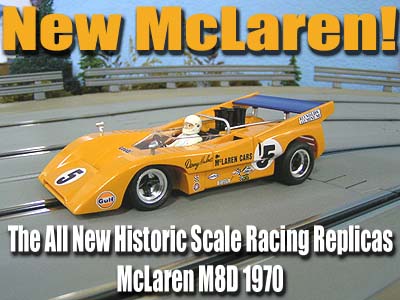 A few
years ago I seen the first prototype photos of this model and like many other
enthusiasts at the time, I was very impressed. It has taken awhile for this
model to finally arrive but it appears that it was worth the wait.
A few
years ago I seen the first prototype photos of this model and like many other
enthusiasts at the time, I was very impressed. It has taken awhile for this
model to finally arrive but it appears that it was worth the wait.
The big question that most people ask is: "Is it 1/32nd Scale?" By all accounts it is very accurate in size and shape. Many people ask this due to the Vanquish MG line of the same models that were made larger (1/28?) and people were hoping these would be on target. I decided to measure this model, a process I do not normally do, just to inform those that need it. I am no expert in the model car measuring department so I apologize if my measurements are not exactly in the areas you need them, however I feel I give enough for you to come to your own conclusions.
The wheelbase is right at 2.9 inches. Due to the steering front wheels it is kind of hard to get them perfectly center, but I did my best. The rear track from the outside of each rear tire is 2.5 inches with the front track at 2.2. The height of the body center mass over the front wheel is 0.872 and 1.263 center mass over the rear. Rear body height from wingtip to the floor is 1.383. Rear body width is at 2.524 and the front at 2.386. Although my measurements don't really mean a lot because I might be off a few millimeters here and there, or I didn't measure exactly what you want, I decided I would ask the good Professor Motor his thoughts. He had not bothered to measure it but just based on his personal comparisons he agreed that HSRR has done an excellent job in finally bringing us this famous model in 1/32nd scale. In reality I could care less just how close it is to exact scale. It is obviously much closer to 1/32nd scale than the VMG line which certainly makes it good enough for me and I am pretty sure it is close enough for most any advanced enthusiast.
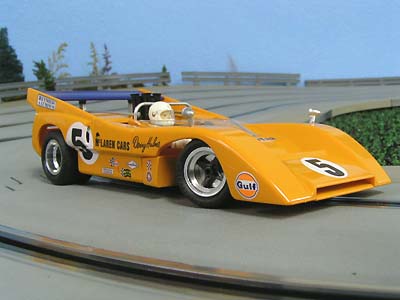
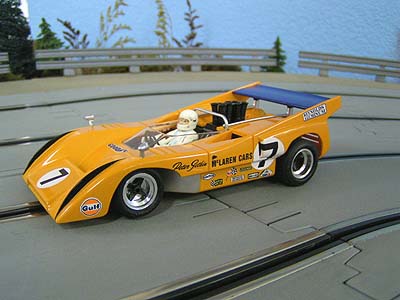
I thought the overall fit and finish on this model was superb. Tampo stamped markings were very crisp and clean and accurately placed. They do however seem to be placed on top of the clear-coat but this could be my eyes getting older. In any event the model looks fantastic to me and compared to prototype photos it seems HSRR has a winner.
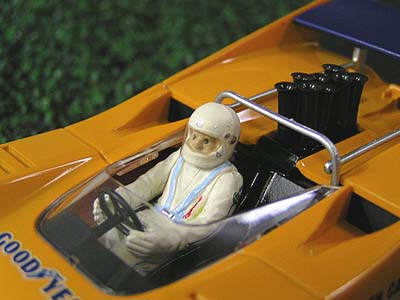
Even the driver detail is outstanding with the visor on the driver helmet being made of a light clear lexan type material that actually flips up. Driver markings are very well done too as different drivers are very accurately painted.
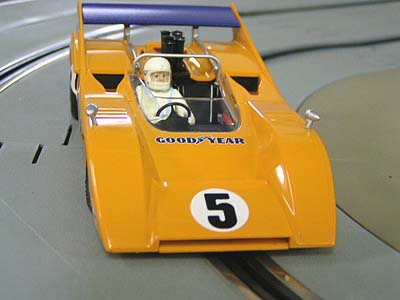
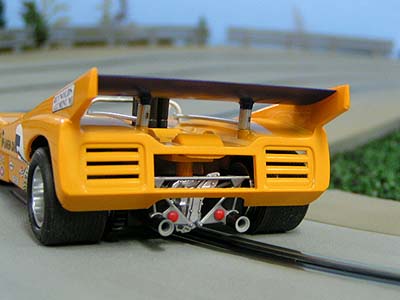
Time now for the OOB (Out of Box) test. From the box to the track this model functioned nicely. We only needed a very slight braid adjustment and we were off to the races! (Sorry...couldn't resist). Operation of this model was smooth and responsive and a pleasure to drive. It passed with flying colors.

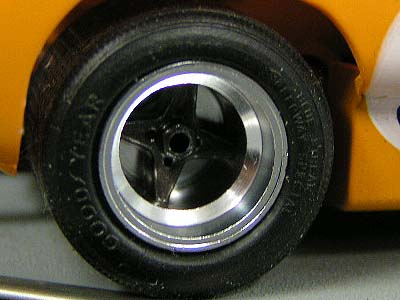
The wheels on this model are all aluminum and as round as you could ask for. The rears are pressed on the axles VERY tightly (the axles have knurled ends) and are sealed with adhesive. It will take some real work to get them off. However, I haven't seen a reason to remove them yet aside from a gear change. Unless you really feel you have too...I would avoid the process. Wheel detailing is more than acceptable for me and should satisfy the scale enthusiast with the accuracy. But it is the tires that impressed me the most. According to the HSRR website, these tires were modeled accurately in the tread design using an actual tire. The tires are the "Hot Shoes" brand of tires that HSRR makes and is a very soft and sticky compound. They really grip our Artin tracks very well but they do need a little sanding to get them true. I say this as there are some very slight molding flash points on the tires where they were pulled from the mold. It isn't a large amount and they only needed a few seconds on light grit paper to get them where I like them.

Up front you can't help but notice that this model is equipped with working steering. In the effort they have put forth in scale realism it makes sense to me to add this feature. So far it has proven to be a very durable set-up and we didn't find a hint of wheel rub in any wheel position. What really impressed me was that they utilized a brass mounting post that really mounts these front wheels flush with the steering assembly and allows virtually no free-play. Again, these are press-fit with adhesive and are very tightly mounted.
Turning the model over we see even more new items. The first is the front guide which is long enough for any plastic track system and 0.214 in depth. I have to say that they could make the guide a little deeper. Most all of today's modern track systems have a deeper slot and having a deeper guide would just reduce unnecessary de-slotting. If owners of tracks such as Scalextric Classic track buy this car then they should have to trim the guide like they do on almost every other brand of car that makes a decent depth guide. It utilizes a folded braid system to allow better electrical contact and the guide holds the braid in very snugly. One thing you might want to aware of is that this guide fits VERY tightly inside the chassis. It took a good sized needle-nose pliers to remove this guide along with some elbow grease. I would suggest that you not remove this guide unless you really feel you need to.
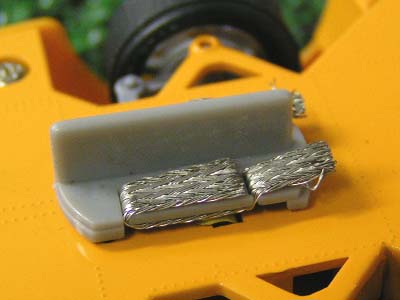

4 screws mount the body to the chassis, but are different sizes so be careful you don't mix them up upon re-assembly. Once removed we see the motor in the sidewinder configuration equipped with a 12 tooth brass pinion that drives a 36 tooth spur gear. The motor appears to be a standard Mabuchi similar to Fly and I don't have any confirmed RPM ratings yet. Needless to say it has enough speed for my tastes.


The rear axle is quite beefy and the bushing fit to the axle is about the closest I have seen. The bushings snap in the chassis VERY tightly as well and do not need any adhesive to keep them secure. These close tolerances are going to need a few minutes of lower voltage break-in to get them to smooth out as they should, but this can be said for almost any model. If you find that your model is a little tight in the side to side free-play area...pop out the axle and trim down the thickness of the spur gear next to the bushing. But again, a good break-in will free this up after only a few minutes.
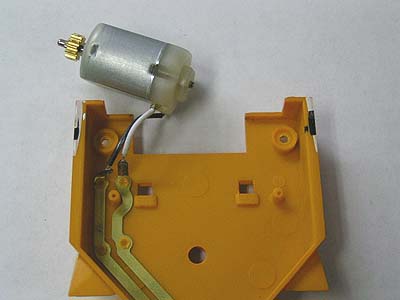
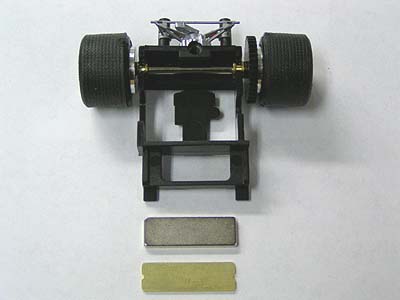
The rear motor pod assemble will pop right out and turning over reveals the 2 mm thick standard bar magnet and a 1 mm thick brass shim on top. This shim allows you to change the magnet out to a thicker 3 mm if feel the need for more magnetic down-force and also would allow you to stack a smaller magnet on top of the original. I thought it was an interesting design and I look forward in hearing other users reports. The model also utilizes a semi-wireless design with brass contact strips molded into the bottom of the body. I like this idea as it helps me re-assemble the model with worrying about pinching any wires.
After we oiled the bushings and motor ends it was time for more racing. Given that the magnet is a good distance from the rails allows a decent amount of down-force, yet you can have some very nice controlled slides. It has very good acceleration and crisp braking and overall a very smooth and sturdy model to pilot. Lap times were an average of 5.5 seconds on our Dixon Hills Speedway, but again the top speed of this model doesn't really mean that much to me. I prefer a lighter magnet model that you have to actually drive instead of just escorting a magnet around the track.
Some feel I should compare this model to others like it...but there really is no other. The Fly 917/10 is a fairly close match but has different gearing and magnet distance placement. This makes the 917/10 have a faster average lap time of 5.3 and has slightly more punch coming out of the corners. I am of the mind that these models should simply be raced against each other to maximize the fun of them.
So will there be others on the way? I don't know. I am sure HSRR will not stop with this series and look forward in hearing any announcements of future models planned. I have been told that these 4 models offered are limited to 3000 pieces combined worldwide and once they are gone...they are gone. I pass this information along as these models are quite popular and if you are thinking about getting some, you might want to do so soon.
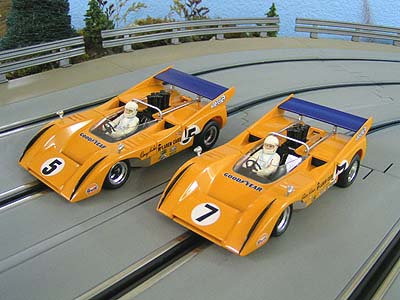 In
the end I think HSRR made a great slot car for their first attempt. The
attention to detail, overall fit and finish, and smoothness of operation can
only make me recommend it for any fan of this series. In fact, anyone in our
hobby should find these to be a worthwhile addition to their current racing
stable.
In
the end I think HSRR made a great slot car for their first attempt. The
attention to detail, overall fit and finish, and smoothness of operation can
only make me recommend it for any fan of this series. In fact, anyone in our
hobby should find these to be a worthwhile addition to their current racing
stable.
- Harry
As always feel free to contact me about this article or just the hobby in general at harry@homeracingworld.com, or better yet drop into our Message Forum and share your thoughts with other enthusiasts!
Thanks Go To Professor Motor For Providing Us With These Great Cars.